"We find them smaller and fainter, in constantly increasing numbers, and we know that we are reaching into space, farther and farther, until, with the faintest nebulae that can be detected with the greatest telescopes, we arrive at the frontier of the known Universe." -Edwin Hubble
While large parts of the internet are blacked out today, in protest of SOPA and PIPA, I could think of no better way to highlight the importance of free exchange of information on the internet than by showcasing one of the most interesting, varied and intricate objects in the entire galaxy: Messier 16, better known as the Eagle Nebula. It's been imaged by literally thousands of different telescopes and instruments, and it's only through the free, public exchange of that information that we've been able to learn as much about this beautiful object as we have. Let's get right to it!
A good-sized amateur telescope, looking up at the Eagle Nebula under excellent seeing condition, will see this vast, dusty expanse of glowing red gas amidst a field of hot, blue stars. The red color teaches us about the hydrogen atoms present, while the darker features within the nebula indicate very dense clouds of gas and dust. This is where new stars are suspected to be forming, but we can't know for sure simply by looking like this.
The very same visible light that allows us to see this intricate structure is the same set of wavelengths that the interstellar dust is very good at absorbing, even with the Hubble Space Telescope!
Very much like the region where our own Sun was born 4.5 billion years ago, these "Pillars of Creation" contain, at the very borders, a large number of evaporating gaseous globules. The light-absorbing dust here is not only where newborn stars are being creating, but these stars are actually in the final stages of growth, as soon the cold gas that can create new stars will be either used up or blasted away.
The false-color showcases the different gaseous compositions of different regions of the cloud (focusing on Oxygen, Hydrogen and Sulfur), but still cannot show us exactly where the vast majority of these ultra-hot, newly formed stars are. But if we can look with a different wavelength of light, sensitive to these stars but insensitive to the intervening dust, we could find out where those stars are.
The Chandra X-ray Observatory, a space-based X-ray telescope, is sensitive to such wavelengths! There are lots of things that emit X-rays: supernova, black holes and neutron stars, as well as hot, ultra-massive newborn stars! It turns out that the evaporating gaseous globules themselves do not contain X-ray emitting stars; in fact most of the X-ray sources are not even in the pillars themselves.
Interesting! But we can learn even more about what is present inside these pillars by looking at still different wavelengths of light. For example, the 8.2 meter Very Large Telescope has taken a look at these pillars in the near-Infrared. What did it find?
Most (but not all) of these evaporating gaseous globules do not contain stars at all, and of the ones that do, pretty much all of the stars in there are less massive (and cooler) than our Sun is!
But looking in the near-infrared can only reveal so much, and leads to even more questions. Are there even less massive stars in there than the VLT can detect? Do each of these globules contain a star (or multiple stars), or are some of them truly sterile? And what came first, these globules or the stars that are inside of them? We tried looking with the ESA's Infrared Space Observatory,
but it didn't have sufficient resolution to teach us anything beyond what we already knew. But just yesterday, the Herschel Space Observatory released an image of the Eagle Nebula that probed deep into the far Infrared, where the hottest (blue) regions represent a temperature of just 40 Kelvin, while the coldest (red) regions are merely 10 Kelvin above absolute zero. Take a look for yourself!
This wide-field image of the Eagle Nebula shows that there's plenty of cool gas still there to form stars even in the hottest regions, but it also shows that the pillars themselves are the hottest regions with the least amount of ultra-cold gas. Yes, the other regions of the nebula are far cooler, and you can clearly see that the interior region looks like a partially carved-out pumpkin, devoid of any cold gas. Know what we think would drive that cold gas away, by heating it up?
A recent supernova. And -- if you remember from earlier -- supernovae would leave a signature in the X-ray. Let's take a wide-field look with the best X-ray telescope in space today: XMM-Newton.
In this image, the red colors are the coldest and the blue are the hottest, with temperatures ranging from only a few million Kelvin up to, for the brightest, darkest blues, around 90 million Kelvin. Let's overlay the XMM-Newton and Herschel images atop one another and see how this stacks up.
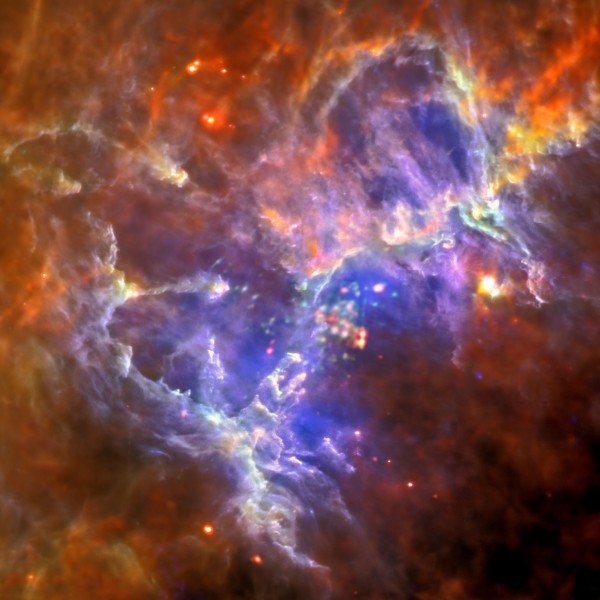
Could there have been a recent supernova at the center? To be honest, they don't know, yet! What you'd look for is faint and diffuse X-ray emission, and you'd see how far it extends around the interior regions of the nebula. If XMM-Newton sees too much of it, it would invalidate this theory, but a small (but non-zero) amount would support it. The work is still being done, but this is the current working theory, and it's consistent with what Chandra (X-ray) and Spitzer (infrared) have seen in their previous observations.
Still wondering about the pillars themselves, and if there are stars forming at the edges there? Let's take a look deep inside the pillars themselves, to the maximum resolution that Herschel can achieve.

Those edge regions, where the evaporating gaseous globules are located, are definitely where the hottest portions of the cold gas are, further evidence that this is where the evaporation is occurring. But although there are some stars inside those globules, are they providing the heat that's causing the evaporation? Or are they simply being formed in regions that are evaporating for entirely unrelated reasons? I wish I had the answer!
It's clear that the pillars are evaporating, but whether there are necessarily stars, proto-stars or any other interior heat source heating up these globules, or if it was a recent cataclysmic release of energy (i.e., from a supernova) nearby is unclear. Where does that leave us? At the edge of our knowledge, where we're pushing the limits of what we currently understand; welcome! There's a wonderful composite image over at Universe Today showcasing all the different data sets, but I prefer this ESA video to illustrate just how remarkable the Eagle Nebula is, looked at with a myriad of different instruments and telescopes.
It's also important to realize that I, personally, have no claim to any of these images, telescopes, or missions. The only reason I can bring you these images, this video, this story and this information is because the entire community of astronomers, astrophysicists and physicists have decided to make all of this information public, and that it should be public. It's not only for the people who work on it, who discover it, or who pay for it; it's for everyone. So share this information -- and all the information about the Universe that we learn from here on out -- with everyone who wants to know it. It's your Universe, too, and we all have a right to it.

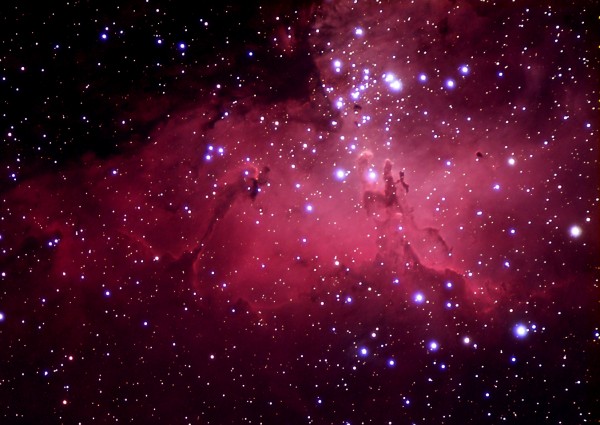
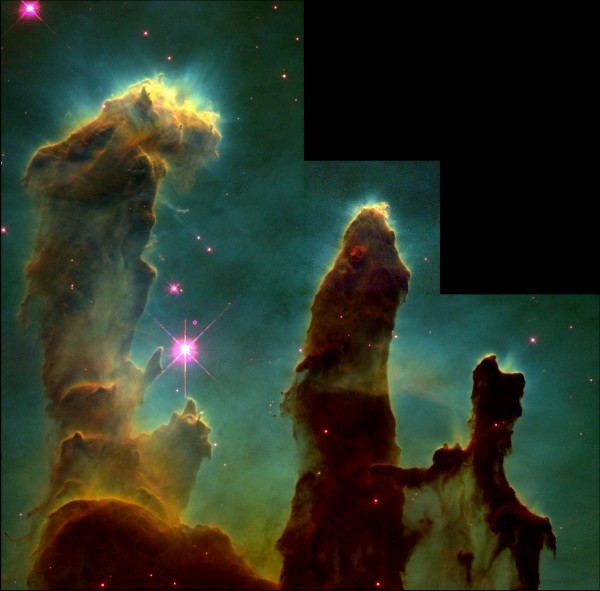
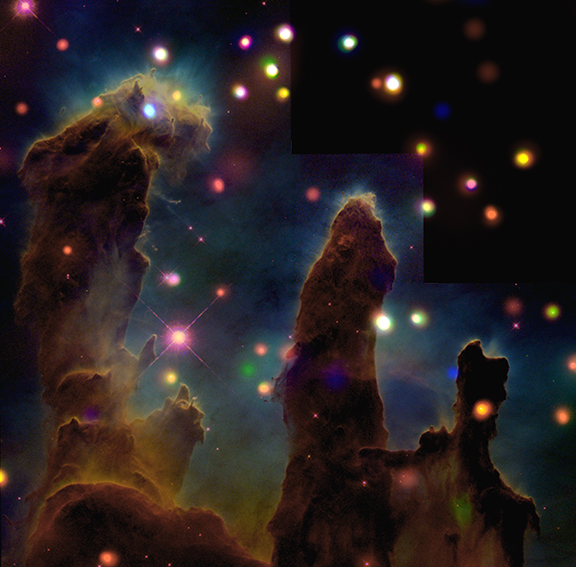
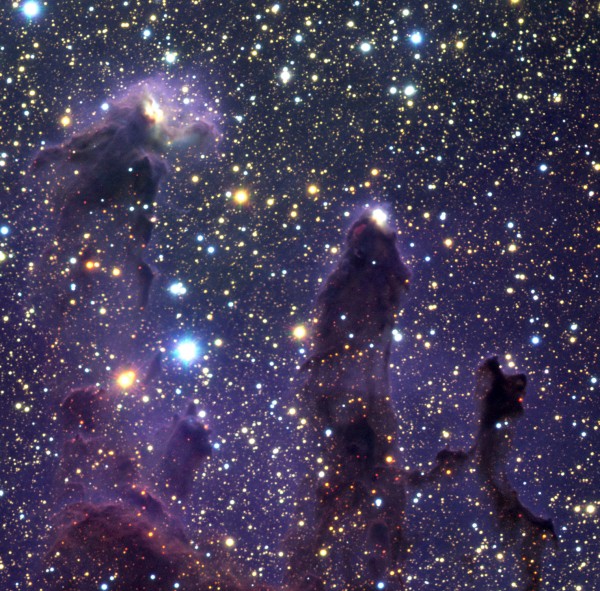
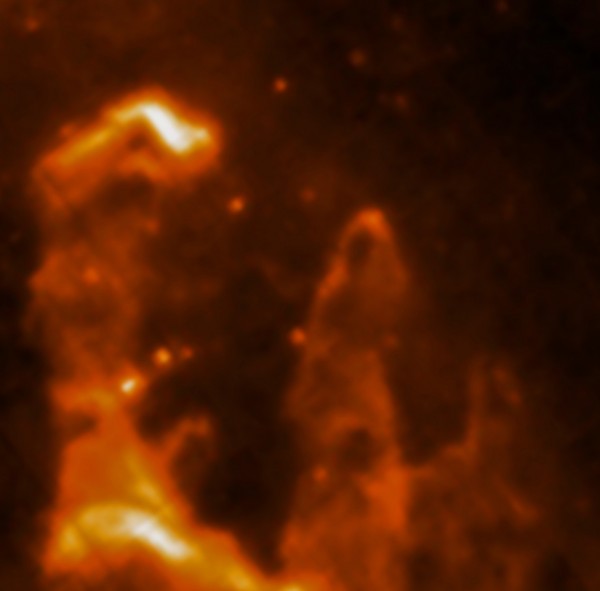
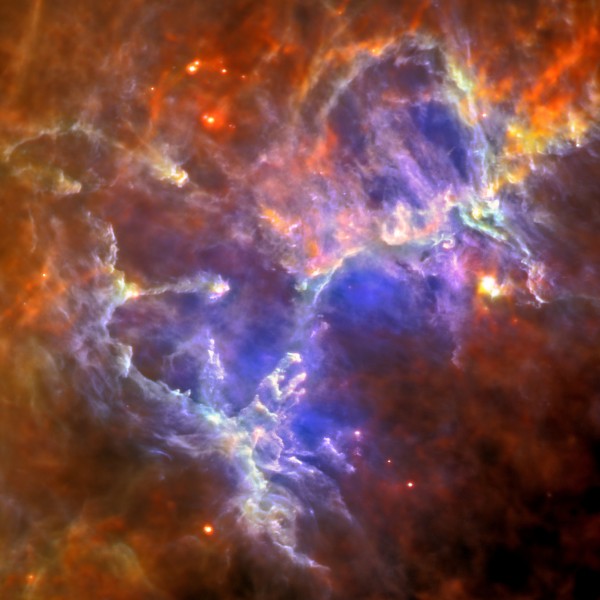
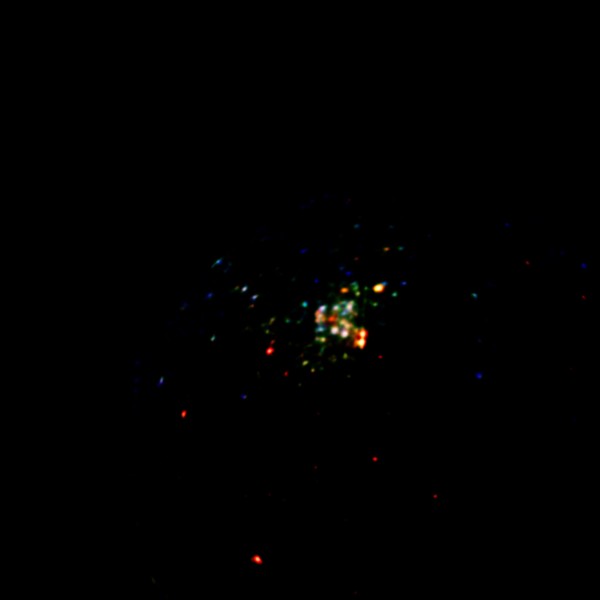
This is some really awesome stuff! I typically like anything related to the Questions of the origin of the Universe! The birth of stars! WOW! Will we ever really know? Maybe,but we will always wonder! It's in our NATURE.
So beautiful and exciting!
Always fascinating what we can figure out from this tiny vantage on earth, and in such a relatively short time at that, especially with shared information and studies. The video was great.
10K-90x10â¶K??? Wow! That's kind of hard to wrap the brain around. Pretty cool, though.
Yes, Ethan, astronomy does illustrate the necessity of free exchange of information in science and benefit of such excahnge.
But remember exchange of information is necessary in the arts as well, e.g. Picasso to Lady Gaga.
If we over protect the status quo; then we stiffle innovation, i.e. the Mickey Mouse copyright law. But if we underprotect, we also stiffle, i.e. how to fund new land based consoritium astronomy telescopes How do we find a balance encourage more innovation? I don't know.
But maybe astronomers have been too generous in making all astronomical photographs public. I mean the royalty pennies could add up and maybe fund in part new astronomy instruments.
The reward of doing great science is to be able to do more great science. But in previous blogs you pointed out that astronomy is underfunded. So, why not figure out how to fund astronomy by charging the going rate for use of astronomy photographs by newspapers, magazines, tv, internet, and movies. when a magazine does an article on elephants; they pay for the elephant photographs. So with budget crisis and such; why should all of the beautiful photos of astronomy from NASA to Hubble to Kitts Peak be free?
The pennies add up; that's why great iPad or Android apps can be sold for pennies. Public domain of astronomy photographs is fine as long as public funding of astronomy flows. But it's not flowing. So maybe its time to rethink??
Just a thought.
Wow can't you build some sort of shield, we are creeped out
I love those moments when you see a photograph of an old familiar nebula/galaxy and all of a sudden the 3D'ness just pops out at you. It's so easy forget when sitting at a telescope or looking at these images on your monitor that the objects actually exist with that strange "depth" property. The Herschel image really brings it out, especially in the video with it superimposed with the xmm-newton & the mpg (I'm actually unfamiliar with this one) images.
On a side note would it be worthwhile to build a stereo satellite telescope pair? I am blanking on the formula (the downfall of being a government major) to determine if even a separation of the pair at say the L4 & L5 points would make a difference in imaging at least the closer/larger nebulae. It would be cool to actually see some greater depth to these things but given the trouble with the JWST would it be worth the double price tag? Just a random thought.
OKThen,
I can see your point but unlike the entertainment industry, these photos aren't released just to be pretty but, as Ethan demonstrates, to be educational.
Most decent educational blogs/ articles (and I include this one) make use of a lot of images and photographs to help demonstrate the lessons they are trying to teach, images which in your model would be charged. While the likes of the BBC or Scientific American might be willing and able to stump up the costs for the photographs, would the likes of Ethan or other small publications?
In addition to the educational problems, images like the Pillars of Creation or the Pale Blue Dot or the Blue Marble are the sorts of images which inspire entire generations of scientists both professional and amateur. I don't think any of us would want to see that inspiration stamped beneath the boot-heels of pay walls and copyright laws.
Maybe a better solution would be to have a recommended donation in order to access the images, similar to the way a lot of museums work? This would raise alittle income without reducing the wonders of the universe to yet another product.
@8 Chrissetti
Yes, yes. Keep protected except for educational and scientific purposes, fair use etc..
But that leaves a significant possible royalty revenue stream; Scientific American, National Geographic, and Nova currently pay top dollar for the best nature photography (or art) on the planet, except for astronomy photographs which they gets for free.
Remember, if astronomy is well funded; the world will have more excellent astronomy and astronomy photographs to write about and show and make movies about.
By the way, I am for open access. I support Google and especially Wikipedia's concerns.
But science has always been a peculiar area regarding intellectual property. On the one hand you can't put a price on all of the innovation that has come from theories of relativity and quantum mechanics; however you can't patent or copyright these theories because they are laws of nature. Well maybe they aren't laws of nature; maybe they are mathematical techniques for calculating engineering parameters, i.e. approximations of nature.
I mean in the music industry you can copywrite a certain type of music phrase; ditto art, literature. Why not certain mathematical phrases. Oh but we can patent a gene, which is a DNA phrase. In my mind a DNA phrase is more a thing of nature than the theory of general relativity (which is an incomplete representation of the thing of nature, i.e. string quantum gravity and beyond).
By the way, there is a big storm in the medical profession. Certain guidelines (i.e. checklists) for diagnostics have been copyrighted. So a physician, hospital, clinic whose uses such a checklist in his or her diagnostic toolkit (whether in program or on paper) is suppose to pay royalties (e.g article in the last 2 or 3 issues of New England Journal of Medicine).
OK, I've stream of conscienced enough. So does science need to reevaluate the proper use of copyright and patent law.
Just some thoughts. I mean as Ethan has said in so many words, everyone is interested in her place in the universe. So make us pay a few pennies here and there; when we see a movie or buy a book.
OK I'll be quiet. But we need to better fund science; not have starving scientists (e.g. astronomers).!!!
I mean if science is underfunded; how do we change that?
is that really true?
Interesting to notice that over eager to sell notion of continually "evolving universe" leads to astrophysicists wrongly and completely incorrectly telling every body online and in astronomy TEXTBOOKS that Pillars of Creation are where new stars are forming. Thanks a lot you stupid phux. take your evolutionary fervor and stick it up your own re-air space.